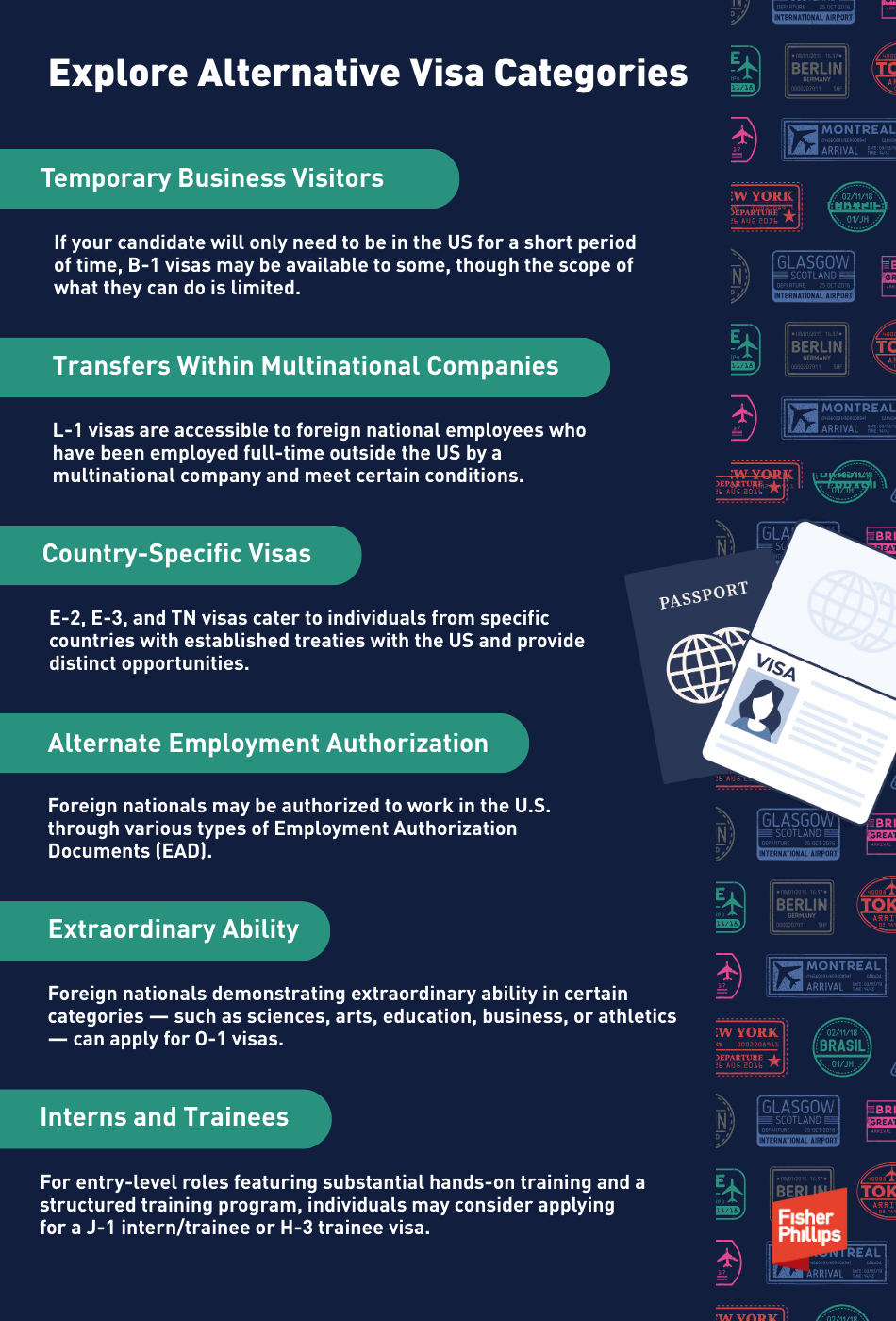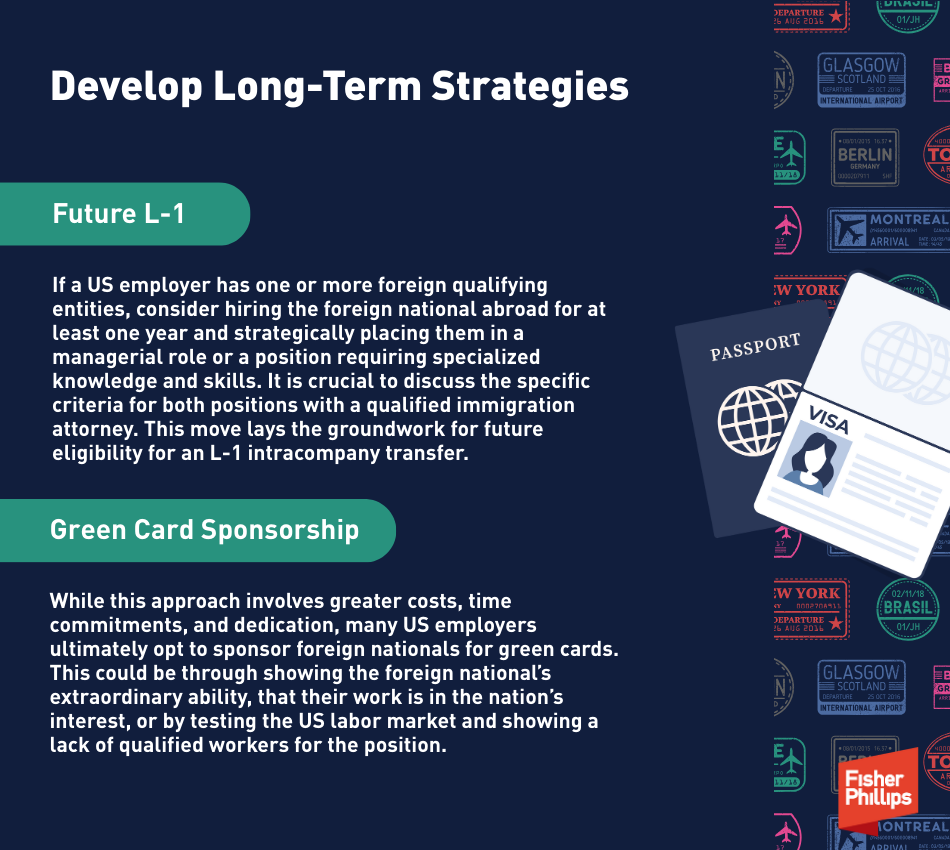Didn’t Make the H-1B Cap? 11 Alternatives for Hiring Foreign Nationals
Insights
4.25.25
You may be disappointed if your candidate was not selected for an H-1B visa in the recent cap lottery – but not all hope is lost. If you employ foreign nationals, the good news is that you can explore certain short-term, long-term, and even some lesser-known solutions. Here are 11 alternatives your organization can use to retain top talent and critical staff, even if your candidate was not selected last month in the FY 2026 H-1B cap lottery.
Consider Additional H-1B Options
1. Potential Second Lottery
H-1B visas are available to foreign nationals with at least a bachelor’s degree (or its equivalent) working in a role deemed to be a “specialty occupation” by US Citizenship and Immigration Services (USCIS). The annual H-1B cap allows for 65,000 “regular” visas and an additional 20,000 visas for workers with a US master’s degree or higher. But you may have a few additional options.
In recent years, the demand for H-1B visas has far exceeded their availability, so USCIS created a random lottery process where employers are required to register the candidates they would like to sponsor for H-1B status. This registration period occurs each March, and the lottery is held at the conclusion to randomly select which registrations will advance further. For selected candidates, employers must then submit a detailed, individual nonimmigrant petition filing. If there are still spots left after the first lottery, USCIS may announce a second lottery sometime after June 30 when the filing period closes – but there is no guarantee this will happen.
2. Beyond the H-1B Cap Lottery
H-1B1 visas are available for nationals from Chile and Singapore, and while there is an annual cap for these visas, it is not filled as quickly. Additionally, some organizations are exempt from the H-1B cap, including certain non-profit organizations and education institutions. This can even include a US employer that is not itself classified as non-profit or an education institution but will concurrently employ a foreign national who works in H-1B status for another qualifying non-profit or education institution.
3. H-1B Portability
A candidate who was previously approved for an H-1B visa through the annual cap lottery is entitled to six years of H-1B time, so they can move to another employer without going through the lottery again. Therefore, if your candidate has a prior H-1B approval with another employer, you may be able to hire that person to work for your company at any time throughout the year. Note that an additional step may be required if you’re seeking to hire a foreign national who has already been counted against the H-1B cap (by changing status to H-1B or by obtaining an H-1B visa abroad) but is not currently employed in H-1B status.
Explore Alternative Visa Categories
4. Temporary Business Visitors
If your candidate will only need to be in the US for a short period of time, B-1 visas may be available to some, though the scope of what they can do while in the US is very limited. Workers may be eligible for a B-1 visa if, for example, they are traveling to the US to consult with business associates, negotiate a contract, participate in short-term training, or attend a conference that is scientific, educational, professional, or business-related.
5. Transfers within Multinational Companies
L-1 visas are accessible to foreign national employees who have been employed, outside the US, on a full-time basis by multinational companies for at least one year in the last three years and intend to transfer to the US to work for a related entity. The US and related foreign position should both be executive or managerial or require specialized knowledge.
6. Country-Specific Visas
E-2, E-3, and TN visas cater to individuals from specific countries with established treaties with the United States and provide distinct opportunities.
- Professionals hailing from Canada and Mexico may leverage the TN status for many professional roles, including accountancy, engineering, scientific technology, and management consulting.
- Additionally, Australian citizens are eligible for the E-3 visa, designed to facilitate their engagement in professional positions akin to those covered by the H-1B category.
- Notably, individuals pursuing E-2 classification must hold citizenship in designated treaty countries and serve in managerial or essential roles for a US employer owned by an organization sharing the same nationality.
7. Alternate Employment Authorization
Some candidates are eligible to apply for an Employment Authorization Document (EAD). You may consider hiring individuals who are already employed under an EAD or those eligible for an EAD obtained through F-1 optional practical training as students.
Additionally, individuals who have completed a STEM (science, technology, engineering, and math) program and are working in a field related to their major might qualify for a STEM EAD, which gives them an additional two-year extension of their EAD card.
Foreign nationals may also enroll in university programs that offer day-one Curricular Practical Training to be able to continue working.
Furthermore, some foreign nationals may be eligible for employment authorization, with or without an EAD, through their spouse’s specific immigration status—such as E-1/E-2 or L-1 status in the US. Under limited circumstances, if their spouse holds H-1B status with an approved Immigration Petition for Alien Worker (I-140), they may also qualify. Moreover, foreign nationals who are dependents in the process of Adjustment of Status to Lawful Permanent Residence (I-485/green card application) through a family member may obtain an EAD while awaiting green card approval.
8. Extraordinary Ability
Foreign nationals demonstrating extraordinary ability in sciences, arts, education, business, or athletics — or extraordinary achievement in the motion picture or television industry — can apply for O-1 visas. Unlike certain visas, O-1 visas don’t have a numerical limit, but obtaining one is a formidable challenge. Applicants must be prepared to meet a high threshold, supply substantial supporting documentation, and face rigorous scrutiny by USCIS.
9. Interns and Trainees
For entry-level roles featuring substantial hands-on training and a structured training program, individuals may consider applying for a J-1 intern/trainee or H-3 trainee visa. To secure these visas, there is a need to demonstrate why the training isn’t readily accessible in the home country and articulate how the skills acquired in the US will be applied in future employment back home and benefit the US company.
Develop Long-Term Strategies
10. Future L-1
If a US employer has one or more foreign qualifying entities, consider hiring the foreign national abroad for at least one year and strategically placing them in a managerial role or a position requiring specialized knowledge and skills. (It is crucial to discuss the specific criteria for both positions with a qualified immigration attorney.) This move lays the groundwork for future eligibility for an L-1 intracompany transfer.
After the foreign national has worked with a qualifying entity for at least one year, the US employer can initiate the L-1 petition, rendering the H-1B unnecessary. Additionally, a US employer might have the opportunity to rehire a foreign national who is currently not part of the global organization but still qualifies for L-1 status based on the regulatory requirement of “one year in the last three years.” These foreign nationals might be overseas or in the US under another status, and they or the US employer may not be aware that they can still meet the qualifications for L-1 status even if not currently employed with the foreign qualifying entity.
11. Green Card Sponsorship
While this approach involves greater costs, time commitments, and dedication, many US employers ultimately opt to sponsor foreign nationals for green cards. This could be through showing the foreign national’s extraordinary ability, that their work is in the nation’s interest, or by testing the US labor market and showing a lack of qualified workers for the position.
Because of lengthy processing times, often for the latter option, the PERM labor certification process is initiated a few years after beginning H-1B employment. This is done to secure the foreign national’s eligibility to continue working beyond the six-year maximum for H-1B status. Sponsoring an employment-based green card for the foreign national may take many years, in some cases over ten years, so it is important to start this early and be prepared – unless they have an H-1B or other long-term visa status, the foreign national may need to leave the US for a period and then apply for an immigrant visa at a US Consulate in their home country.
When multiple attempts at the H-1B lottery are necessary, the PERM-based green card process might offer a future route to obtaining work authorization for a foreign national. This assumes, of course, that the US employer is willing to provide a more permanent employment arrangement once the green card is issued, rather than a nonimmigrant temporary employment situation. In any case, most states permit “at-will” employment offers, making green card sponsorship a viable long-term option while preserving the right for both the employer and the employee to terminate the employment relationship.
You should note, however, that discrimination claims are rising against employers accused of favoring foreign national workers over US workers. Click here to learn more about minimizing risks while still engaging in lawful green card sponsorship.
Conclusion
Fisher Phillips stands ready to assist you as you explore alternative solutions. If you have questions, please contact your Fisher Phillips attorney, the authors of this Insight, or any attorney in our Immigration Practice Group. We will continue to monitor further developments and provide updates on this process, so make sure you are subscribed to Fisher Phillips’ Insight System to gather the most up-to-date information.
Related People
-
- Jocelyn Campanaro
- Partner
-
- David S. Jones
- Regional Managing Partner
-
- Shanon R. Stevenson
- Partner





